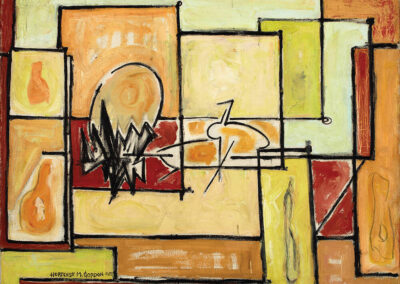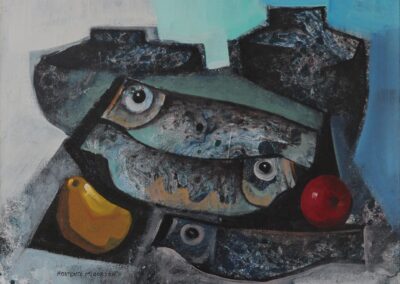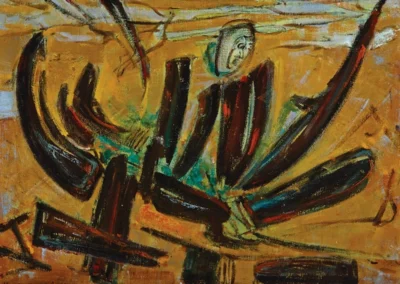Our next Artist You Need To Know is Hortense Gordon (1886 – 1961).
Hortense Mattice Gordon was a Canadian artist, arts advocate and educator : she was one of two female founding members (the other being previously featured Artist You Need To Know Alexandra Luke) of the Ontario – based group of abstract artists known as Painters Eleven. Her early works explored landscape and still life, but like other members of P11 / Painters Eleven, Gordon was strongly influenced by Abstract Expressionism both from the United States and Europe. Gordon also was an intrinsic part of the Hamilton cultural scene, as she taught design and applied arts, such as ceramics, in that city for many years and was intimately involved with numerous artistic groups in Hamilton.
A major influence on Gordon’s artwork and ideas, the German born American painter and teacher Hans Hofman stated that “She never stood still, never looked back and never ceased to give to others, a truly creative artist.”
Gordon was born in Hamilton, ON : encouraged by her father from the time she was very young (he would give her sheets of copy paper, as he was a ‘newspaperman’ and tell her to fill them with sketches, daily), Gordon had decided by her teens that she wanted to be an artist. Moving to Chatham (ON), Gordon taught art to high school students while having her own studio.
One of the works she produced during this period was accepted into a Royal Canadian Academy of Arts juried exhibition : this caught the attention of John S. Gordon, who was an artist as well as being the Head of the Art Department at the Hamilton Technical Institute. The work made such an impression upon him that when the opportunity presented itself in 1916, he hired her as a teacher at the Institute. In 1920, they married.
During their marriage there were frequent trips to Europe during which they immersed themselves in the various art movements at play on the continent. This led to some experimentation in Gordon’s work, incorporating some of these more radical ideas : a similar response was motivated by the rise of the Group of Seven.
John Gordon would retire in 1934 from the Hamilton Technical Institute, due to ill health that would claim his life in 1940 : Hortense Gordon became the new head of the school and would hold this position until 1951, when she retired from teaching.
Hortense Gordon became a member of the Ontario Society of Artists in 1908, and in 1930 was accepted as an associate of Royal Canadian Academy of Arts in 1930. Gordon was also an essential member of the Hamilton Women’s Art Association and in the 1930s she was instrumental in their ongoing ‘speakers series’ (focused on both artists and writers).
Gordon began to work in abstraction in the 1930s – a visit to the MOMA in New York City impressed her so much that this soon became her specific approach to painting. This led to an exhibition In 1946 at the Brantford Public Library that included many of these works. In 1947 she studied under groundreaking artist, teacher and theoretician Hans Hofmann at Provincetown, Cape Cod (she was joined by Alexandra Luke, and they were among the first Canadian artists to participate in this venture).
She would have her first solo exhibition in New York City in 1952 and in 1955 she was part of an exhibition at Roberts Gallery in Toronto that platformed artists working non – objectively and in abstraction. This group would become known as Painters Eleven and included Jack Bush, Oscar Cahen, Tom Hodgson, Alexandra Luke, J.W.G. MacDonald, Ray Mead (also a previously featured Artist You Need To Know), Kazuo Nakamura, William Ronald, Harold Town and Walter Hawley Yarwood.
Gordon’s work was a highlight of the show : “It was in this regard that Dr. Freda F. Waldon commented, “It was a tribute to her youthful spirit . . . that she was asked to join Painters Eleven in Toronto.” While others in this group were non-objective in their painting Hortense Gordon always started her work with an object or experience of the elements as a basis, and she remained within the realm of the abstract in all her work. A caption to her photo in Mayfair may best sum up her paintings, “A painter of everything from hurricanes to old boats, Mrs. Hortense Gordon of Hamilton, Ontario, reduces her subjects to bright powerful abstracts.” (Colin S. Macdonald, writing for National Gallery of Canada)
Hortense Gordon was an Associate of the Royal Canadian Academy, a member of the Canadian Society of Graphic Artists, the Contemporary Artists of Hamilton, the Women’s Art Association of Hamilton (as a founding member), the Ontario Society of Artists (which she joined in 1904), North Shore Arts Association of Gloucester (Massachusetts, USA), the International Federation of Art (Zurich, Switzerland), and the Art Teachers Guild (London, ON). As previously stated, Gordon was also a founding member of Painters Eleven in 1953.
Notable solo exhibitions over her career were mounted at Galerie Agnes Lefort, Montreal (1952), and at the Burlington Public Library (1957). She was a regular participant in the annual exhibitions of Hamilton artists (over the impressive span of 1927 – 1940) and the annual exhibitions of the Hamilton Women’s Art Association, the Contemporary Artists of Hamilton and with the Art Club of Hamilton. Concurrently, Gordon was exhibiting with Painters Eleven in various exhibitions in Montréal and Ottawa. As well, she was included in Four Modern Canadians at the Willistead Art Gallery (1954), Canadian Women Artists at Riverside Museum, New York, 1952 and at the 20th Annual Exhibition of American Abstract Artists with Painters Eleven (1956).
Two significant posthumous retrospectives of Hortense Gordon’s artwork took place at the Thames Art Gallery (1993) and The Robert McLaughlin Gallery (1994).
Gordon’s work can be found in numerous public and private collections : these include the National Gallery of Canada (Ottawa), The Robert McLaughlin Gallery (Oshawa), Thames Art Gallery, (Chatham), the Art Gallery of Hamilton (Hamilton), and the Rodman Art Institute of Niagara.
When Hortense Gordon’s memorial exhibition at the Hamilton Art Gallery opened, Dr. Freda F. Waldon offered the following regarding the artist’s life and legacy : “I think in the long run what everyone who knew her will remember best was her immense zest for life, her conviction that art is supremely important, her great capacity for fun, her enjoyment of a party, which were all part of her vital response to life. Vivid personality and vitality are the words that inevitably come to mind when you think of Hortense Gordon. And Indomitable. A gallant fighter to the very end.”
Hortense Gordon was hospitalized for emphysema and a heart condition in 1961, and passed away in November of that same year in Hamilton. More about her life and accomplishments can be seen here and here.






























